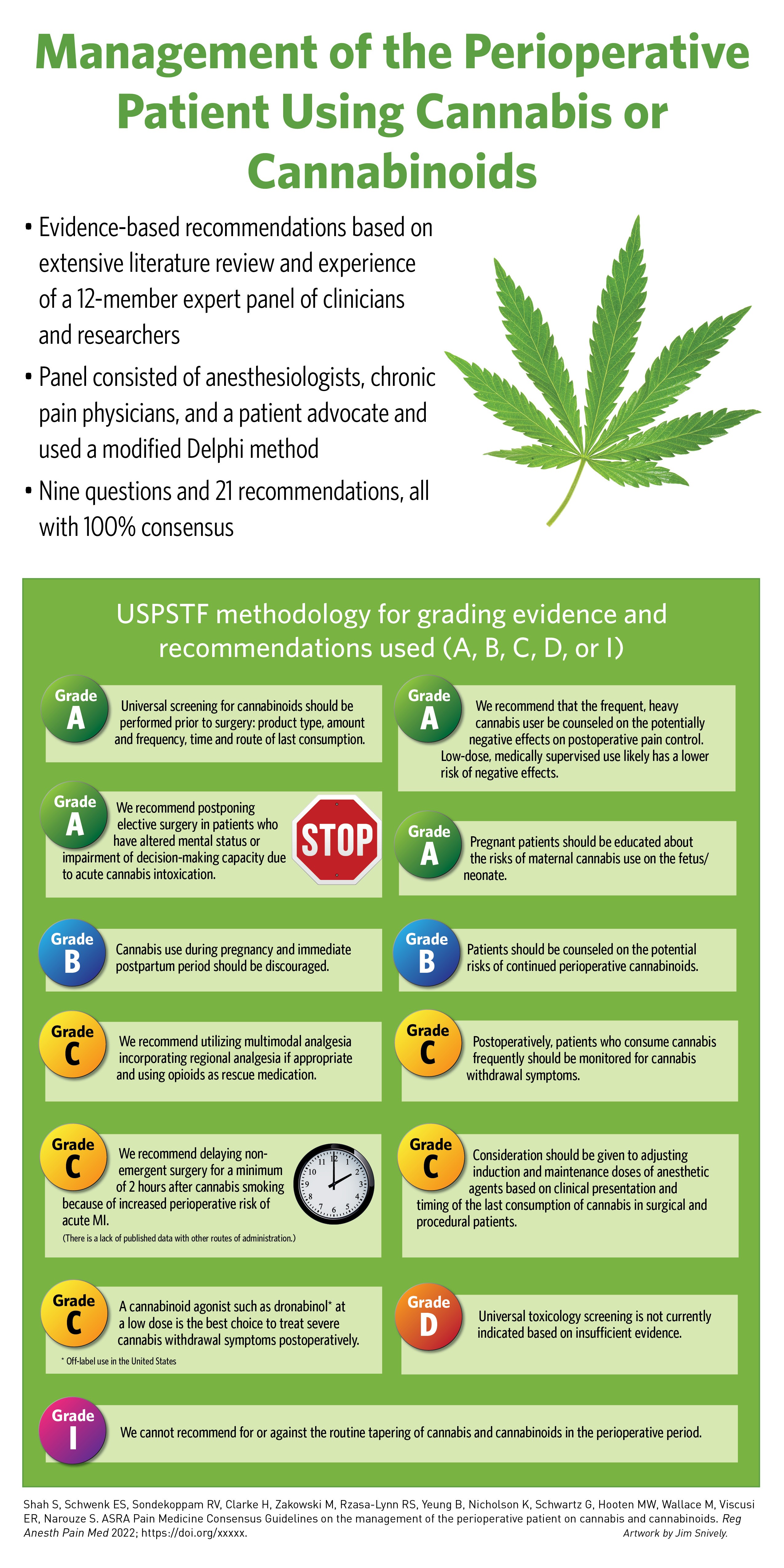All Patients Should be Screened for Cannabis Use Before Surgery, First U.S. Guidelines Recommend
Frequent Users Should be Informed of Potentially Poor Response to Pain Control, Suggests ASRA Pain Medicine Guidelines for the Management of Cannabis Related to Surgery
All patients undergoing procedures requiring anesthesia should be asked about cannabis use, according to guidelines released today by the American Society of Regional Anesthesia and Pain Medicine (ASRA Pain Medicine). The first U.S. guidelines on cannabis use in relation to surgery also notes regular use may worsen pain and nausea after surgery and increase the need for opioids.
"Even though some people use cannabis therapeutically to help relieve pain, studies have shown regular users may have more pain and nausea after surgery, not less..." - ASRA Pain Medicine President Samer Narouze, MD, PhD
The guidelines were developed in response to the increased use of cannabis during the past 20 years and concerns that it potentially can interact with anesthesia and lead to complications. About 10% of Americans use cannabis monthly, and it is the most commonly used psychotropic substance after alcohol, according to the U.S. Substance Abuse and Mental Health Services Administration.1,2
“Before surgery, anesthesiologists should ask patients if they use cannabis – whether medicinally or recreationally – and be prepared to possibly change the anesthesia plan or delay the procedure in certain situations,” said Samer Narouze, MD, PhD, senior author and ASRA Pain Medicine president. “They also need to counsel patients about the possible risks and effects of cannabis. For example, even though some people use cannabis therapeutically to help relieve pain, studies have shown regular users may have more pain and nausea after surgery, not less, and may need more medications, including opioids, to manage the discomfort. We hope the guidelines will serve as roadmap to help better care for patients who use cannabis and need surgery.”
The guidelines recommend anesthesiologists screen all patients for cannabis use, including asking about the type of cannabis product used, how it was used (eg, smoked, ingested), amount used, how recently it was used and frequency of use.
The guidelines are based on an extensive literature review and experiences from the organization’s “Perioperative Use of Cannabis and Cannabinoids Guidelines Committee,” composed of 13 experts, including anesthesiologists, chronic pain physicians and a patient advocate. The committee addressed nine questions and made 21 recommendations using a modified Delphi consensus method with >75% agreement required for recommendation. Recommendation grades were based on the United States Preventive Services Task Force (USPSTF) process that assigns a letter (an A, B, C, or D grade or an I for insufficient) based on the strength of the evidence and the balance of benefits and harms. All 21 recommendations achieved full consensus.
This is the first U.S.-based guideline on perioperative (before, during and after surgery) management of cannabis, according to lead researcher Shalini Shah, MD, vice chair of anesthesiology at the University of California at Irvine School of Medicine. The guidelines cover preoperative, intraoperative and immediate postoperative care considerations. The American Society of Anesthesiologists reviewed the guidelines and is in agreement with their recommendations and affirms their value for anesthesiologists and surgeons. They are not intended to replace clinical judgement but rather promote improved patient communication and possibly improved outcomes.
Recommendations receiving an A grade support (the highest level of evidence) include: 1) screening all patients before surgery, 2) postponing elective surgery in patients who have altered mental status or impaired decision-making capacity at the time of surgery, 3) counseling frequent, heavy users on the potentially negative effects of cannabis use on postoperative pain control and 4) counseling pregnant patients on the risks of cannabis use to the unborn child.
All recommendations are shown in the infographic below.

References
- National Academies of Sciences, Engineering, and Medicine; Health and Medicine Division; Board on Population Health and Public Health Practice; Committee on the Health Effects of Marijuana: An Evidence Review and Research Agenda. The Health Effects of Cannabis and Cannabinoids: The Current State of Evidence and Recommendations for Research. Washington (DC): National Academies Press (US); January 12, 2017. https://www.ncbi.nlm.nih.gov/books/NBK425741/#sec_000012
- Substance Abuse and Mental Health Services Administration. Key substance use and mental health indicators in the United States: Results from the 2017 National Survey on Drug Use and Health (HHS Publication No. SMA 18-5068, NSDUH Series H-53). Rockville, MD: Center for Behavioral Health Statistics and Quality, Substance Abuse and Mental Health Services Administration, 2018. Accessed June 26, 2022. https://store.samhsa.gov/product/Key-Substance-Use-and-Mental-Health-Indicators-in-the-United-States-Results-from-the-2017-National-Survey-on-Drug-Use-and-Health/SMA18-5068